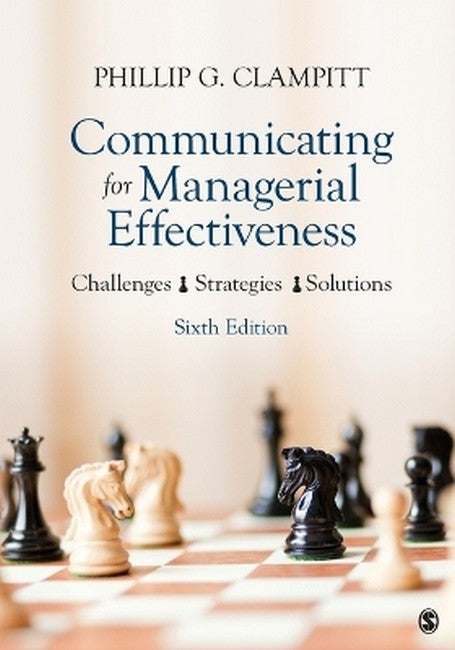Phillip G. Clampitt (PhD, University of Kansas) is the Blair Endowed Chair of Communication at the University of Wisconsin-Green Bay. He was previously designated the Hendrickson Named Chair of Business. The Wall Street Journal and MIT Sloan Management Review has highlighted his work on "Decision Downloading," which details how companies can effectively communicate decisions to those not involved in the decision-making process. He is the author of a SAGE Publications best seller, Communicating for Managerial Effectiveness 5e (see www.imetacomm.com/cme4), co-author of the forthcoming Progress Makers: Beyond the Desire to Lead (SAGE, and co-author of Embracing Uncertainty: The Essence of Leadership. Along with being on the editorial board of numerous professional journals, his work has been published in a variety of journals including the MIT Sloan Management Review, Academy of Management Executive, Management Communication Quarterly, Journal of Business Communication, Communication World, Journal of Broadcasting, Journal of Communication Management, lvey Business Journal, and Journal of Change Management. In addition to many guest speaking opportunities in the U.S., he has also been invited to speak internationally at The University of Pisa, The University of Aberdeen, The University of Ulster, as well as to numerous multinational businesses and professional organizations. As a principal in his firm, Metacomm, he has consulted on communication issues with a variety of organizations, such as PepsiCo, Manpower, Schneider National, American Medical Security, Dean Foods, The Boldt Company, Stora Enso, The U.S. Army War College, Appleton Papers, Foremost Farms, Thilmany Paper, Dental City, and Nokia (see www.imetacomm.com).
Request Academic Copy
Please copy the ISBN for submitting review copy form
Description
Foreword Preface Introduction SECTION 1. FOUNDATION Chapter 1. Understanding Communication Propositions Implications of the Propositions Conclusion Key Concepts "Drill Down" Exercises Chapter 2. Examining Communication Approaches The Arrow Approach The Circuit Approach Communication as Dance Conclusion Key Concepts "Drill Down" Exercises Chapter 3. Scrutinizing Ethical Issues Fundamental Assumptions Ethical Dilemmas A Strategic Approach to Corporate Ethics Conclusion Key Concepts "Drill Down" Exercises Chapter 4. Imparting the Organizational Culture What Is Culture? Does Culture Matter? How Can We Discover Culture? How Can We Evaluate Culture? How Can Leaders Effectively Impart the Culture? Conclusion Key Concepts "Drill Down" Exercises SECTION 2. COMMUNICATION CHALLENGES Chapter 5. Selecting and Using Communication Technologies The B - C Model: A Deeper Look How Perspective Affects Value What to Do? Conclusion Key Concepts "Drill Down" Exercises Chapter 6. Managing Data, Information, Knowledge, and Action The D-I-K-A Model Variations of the Model Managing the Data-Information Relationship Managing the Information-Knowledge Relationship Managing the Knowledge-Action Relationship Conclusion Key Concepts "Drill Down" Exercises Chapter 7. Providing Performance Feedback Performance Feedback Principles Implementing a Successful Feedback System Communicating Performance Feedback Conclusion Key Concepts "Drill Down" Exercises Chapter 8. Communicating across Organizational Boundaries The Nature of Boundaries Potential Problems of Boundaries Contributing Factors What to Do? Conclusion Key Concepts "Drill Down" Exercises Chapter 9. Structuring and Using Robust Decision-Making Practices Decision-Making Tensions Pre-Decision-Making Checklist The Robust Decision-Making Model Strategies for Optimizing the Decision-Making Process Conclusion Key Concepts "Drill Down" Exercises Chapter 10. Communicating about Change Approaches to Change Selecting the Degree of Communication Reactions to Change The "Iceberg" Model Conclusion Key Concepts "Drill Down" Exercises Chapter 11. Cultivating the Innovative Spirit Misconceptions What Is Innovation? A Perspective on Success and Failure Strategic Traffic Signals Conclusion Key Concepts "Drill Down" Exercises Chapter 12. Building a World-Class Communication System Assess Strategize Implement The Assess-Strategize-Implement Cycle in Action Conclusion Key Concepts "Drill Down" Exercises Glossary Notes Index About the Author
"The best practical guide available for integrating complexity into effective managerial practice. Clampitt's unique, up-to-the-minute, and leading-edge focus on communication practices give managers an essential set of skills for effectively navigating today (1)s most difficult complex organizational problems. Communicating for Managerial Effectiveness identifies a common set of complex problems all managers face and details specific communication-enhanced strategies and tactics for moving past those problems toward successful solutions. Advanced undergraduate and MBA students especially resonate with Clampitt's practice-tested and strategically focused methods for action." -- James Barker, Professor and Herbert S. Lamb Chair of Business Education, Rowe School of Business "This is a comprehensive text that addresses communication from a multidisciplinary approach and reflects contemporary management practice." -- Dr. Joseph T. DeRanieri "Phil Clampitt takes the mystery out of understanding managerial communications. His engaging style of presenting important communication concepts has my students reading beyond their assignments. Prompting students to discuss the text in class has never been easier." -- Robert J. Trosky, Jr., D.Sc., "I have been searching for a text I could use that presented clear, skill-based, practical suggestions my students could implement in the business world along with a theoretical background that would provide a depth of understanding as to why those skills are successful. This textbook does just that. It is a terrific blend of theory, skills and provides real business-based practicum and analysis assignments for the students to apply what they learned in each chapter." -- Teresa Raehpour "This is an excellent text to use for students seeking a degree in Organizational Leadership because it addresses more of the communication challenges that leaders face (e.g. performance feedback discussions, communicating about organizational change)." -- Carol Howard "This book is one of the few which is a 'must read' in the field of management communication. Phil Clampitt combines a deep understanding of the research with an unparalleled sensitivity to the needs of practitioners. He has produced a text which is stimulating, fun to read and which transforms the way in which we think about communication in organizations. Wise executives will study its pages in order to steal ideas about best practice from one of the best in the business. The winners will be the organizations they work for. The losers will be the competition." -- Dennis Tourish, Professor of Leadership and Organization Studies "This text is a treasure trove for us in and out of the classroom." -- Steven Ralston

